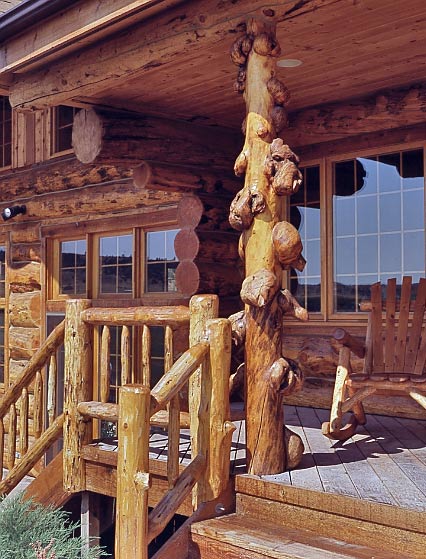 Wood as a decorative medium can generally be broken down into three categories: carvings, burls, and bark. Carvings are self-explanatory. According to Anthony R. Brach of Harvard University Herbaria, a burl is “a hard, woody outgrowth on a tree, more or less rounded in form, usually resulting from the entwined growth of a cluster of buds.” When stripped of bark, the burl shows sometimes extraordinary gnarls and cat-faces.
Wood as a decorative medium can generally be broken down into three categories: carvings, burls, and bark. Carvings are self-explanatory. According to Anthony R. Brach of Harvard University Herbaria, a burl is “a hard, woody outgrowth on a tree, more or less rounded in form, usually resulting from the entwined growth of a cluster of buds.” When stripped of bark, the burl shows sometimes extraordinary gnarls and cat-faces. See the photo at right and the large log that braces this kitchen. Bark refers to both the exterior of a tree and the dark cambium layer that, when placed next to the lighter colored wood, provides a dramatic contrast. Wood carving, of course, has been a favorite artistic pursuit for centuries, but in recent decades it’s become a preferred method of personal expression within log homes. Richard Cornelius, a carver based in Wheatridge, Colo., says that demand is on the upswing, as log home owners have become more aware of the decorative potential that comes with whittling, paring, and shaping milled and natural wood. “It still remains a luxury,” he says, “but it is definitely more common.”
Nature’s own inspired creations come to light when a homeowner utilizes burl and bark as an accent or focal point. Character logs are a favorite way to contrast perfectly milled logs with trees in their rawest form. “They possess character, with lots of natural bumps, knots, and deformities,” explains Dennis Kelvie, a designer for Rocky Mountain Log Homes in Hamilton, Montana, who adds that his clients often opt for oversized logs and place them in highly trafficked or visible areas. “It really gives the log home a throwback feel, a more antiquated look that reminds people of 18th- and 19th-century log homes that didn’t have uniformity to their construction.”
Character logs can serve any number of architectural and decorative functions. In using them as support posts in entryways or great rooms, some clients choose to leave the branches on them to provide an even greater rustic feel to their homes. Cut in half, they can also be used as fireplace mantels and knee braces, in the kitchen as a foundation for a bar or center island, or even as benches and stair steps. Bark, although used more rarely, works best as a decorative accent.
Some homeowners use it to dress up, for example, a mirror or picture frame, but Kelvie cautions that raw bark can be problematic if it’s not dried properly. A more popular and long-lasting form of bark is cambium, which Stairmeister uses as stair spindles and center columns to provide a contrast to steps and banisters made of traditional milled wood. “The darkness of the cambium really stands out against the lighter wood,” Horning says. “It’s a very dramatic effect.”
Experts recommend a couple of strategies when planning your wood décor:





